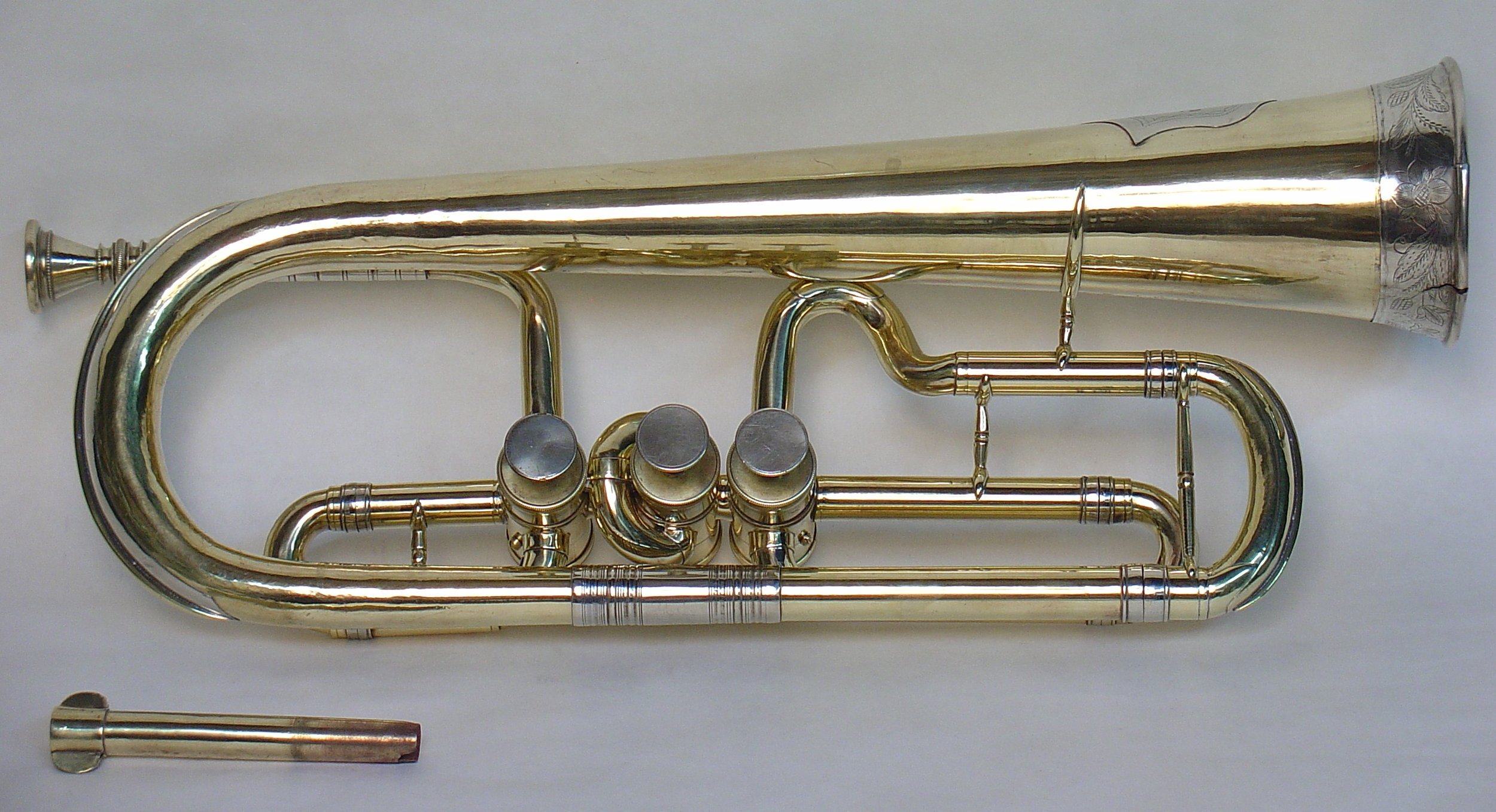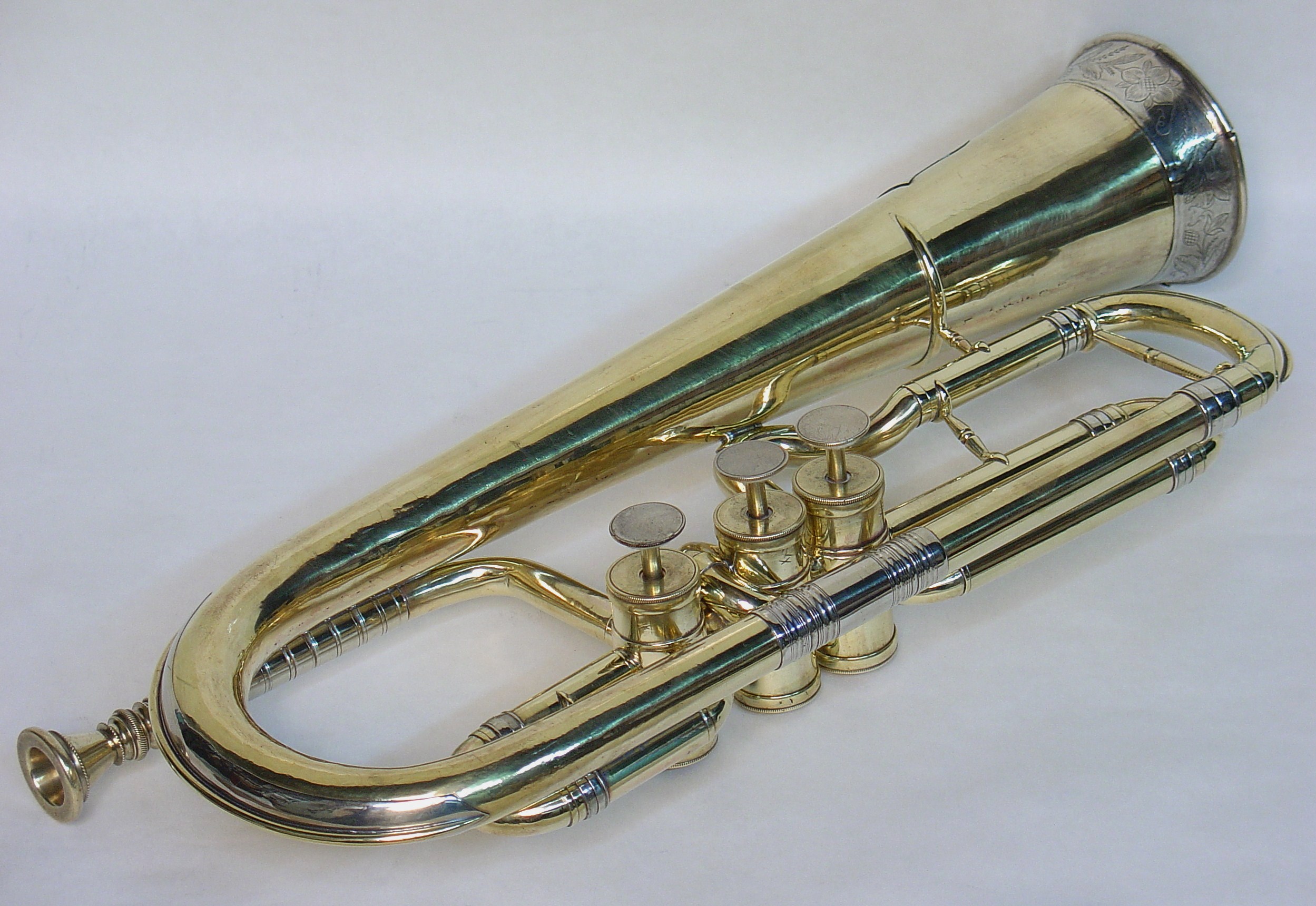A Prussian Kornett from Poland and a Swedish Kornett from Norway
This form of valve bugle or flugelhorn with notably little flare in the bell, is known to us as a Prussian cornet and would serve the same purpose as the flugelhorn or cornet in military bands and the like. The earliest successful valved brass instruments seem to have originated in Prussia before 1820 and were patented there in 1818 by Friedrich Blühmel and Heinrich Stölzel. The patent covers rectangular section or "box" valves that otherwise function the same as the cylidrical "Berliner" valves in this instrument. The Berliner valve first became widely popular in the 1830s by the maker Johann Gottfried Moritz in collaboration with the band leader Wilhelm Wieprecht and can also be seen on the German trumpet and French Saxhorn also featured on this site. The flugelhorn or valve bugle was first made about 1827 as an improvement of the keyed bugle, in Munich and various regional forms remain popular throughout the world.
The city of Stettin (the German name for Szczecin, Poland's largest seaport today) had been part of Prussia since the early 18th century and presumably, this was the traditional soprano or alto voice in the military bands of the region at the time it was made (1860s). The signature on this instrument "C.H. Grimm" is so obscure that we don't know what "C.H." abbreviates. While this could be the maker's name, it could also be a dealer or music store. This style of instrument had its greatest popularity in Prussia from about 1840 until more modern German style flugelhorns and trumpets took their place several decades later. At the same time, very similar instruments were standardized in Sweden and Norway and is where this form of cornet or valve bugle lasted the longest and with rotary valves it is called a Swedish cornet (kornett). Copenhagen is just a boat ride away from Szczecin, across the Baltic Sea.
This cornet by Grimm could have been made in the far north of Europe, but might have been imported from one of the large German or Austrian makers that were supplying the world with brass instruments at the time. The flower and leaf engraving that decorates the nickel silver garland is typical of Saxon makers. Much research is yet to be done on this subject. The best information on brass instrumental music from this time and region is to be found in Ann-Marie Nilsson's article "Brass Instruments in Small Swedish Wind Ensembles in the Late 19th Century", Historic Brass Society Journal, vol. 13, 2001 and Ed Tarr and Stewart Carter's "East Meets West, the Russian Trumpet Tradition...".
This instrument has suffered much abuse and failed repairs, but I decided that it was interesting enough to preserve and restore. The valves are somewhat loose, but
it plays with thick oil on them. The existing mouthpiece and shank for A came with the cornet and I believe that they were used with it originally. The mouthpiece is very much like one for a Bb keyed bugle, with a wide, flat rim and funnel shaped cup. The over all length with mouthpiece removed is 15 1/2", the bell rim diameter is 3 1/4" and the bore measures .454".
Also notable on this instrument is the name shield that was engraved by an early (original?) owner of this cornet. The name appears to be "Anton Stroinski" and he thought enough to engrave the year as well. It seems likely that this instrument was new in 1862. Stroinski is not an uncommon Polish name. Indeed, a Google search associates a number of people of that name with the city today. I hope that a genealogical search leads Anton's descendants to this page eventually.
The last two photos below show an Eb soprano Swedish cornet made (or at least sold originally) in Oslo, Norway by William Farre in the 1930s. Farre was known to be a dealer and likely had instruments made to his design in Germany. Presumably, this was the last iteration of the Swedish cornet.










